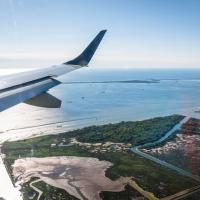[ad_1]
Geneva – The International Air Transport Association (IATA) announced global passenger traffic results for May showing that demand (measured in revenue passenger kilometers, or RPKs) rose 6.1% compared to the same month in 2017, which was a slight pickup from 6.0% year-over-year growth for April 2018. Capacity climbed 5.9% and load factor rose 0.1 percentage point to 80.1%.
“May was another solid month in terms of demand growth. As had been expected, we saw some moderation, as rising airline costs are reducing the stimulus from lower airfares. In particular, jet fuel prices are expected to be up nearly 26% this year compared to 2017. Nevertheless, the record load factor for the month signifies that demand for air connectivity is strong,” said Alexandre de Juniac, IATA’s Director General and CEO.
|
May 2018 |
World share¹ |
RPK |
ASK |
PLF |
PLF (level)³ |
|
Total Market |
100.0% |
6.1% |
5.9% |
0.1% |
80.1% |
| Africa |
2.2% |
-0.8% |
-0.9% |
0.0% |
66.8% |
|
Asia Pacific |
33.7% |
8.7% |
8.6% |
0.1% |
79.6% |
|
Europe |
26.5% |
6.0% |
5.0% |
0.8% |
83.0% |
|
Latin America |
5.2% |
6.1% |
6.2% |
-0.1% |
79.8% |
|
Middle East |
9.5% |
0.5% |
3.3% |
-1.9% |
67.5% |
|
North America |
23.0% |
5.2% |
4.9% |
0.3% |
84.4% |
¹% of industry RPKs in 2017 ²Year-on-year change in load factor ³Load factor level
International Passenger Markets
International passenger traffic demand rose 5.8%, which was up from 4.6% growth in April. All regions recorded growth, led by Asia-Pacific airlines. Total capacity climbed 5.4%, with load factor rising 0.3 percentage point to 78.7%.
- Asia-Pacific airlines saw their traffic rise 8.0% in May compared to the year-ago period, slightly down on an 8.1% increase in April. Capacity increased 7.6%, and load factor edged up 0.3 percentages point to 77.9%. Passenger traffic has continued to trend strongly upwards in seasonally-adjusted terms, buoyed by a combination of robust regional economic growth and increases in the number of route options for travelers.
- European carriers’ May demand climbed 6.2% over May 2017, well above the 3.4% year-over-year growth recorded in April. Capacity rose 5.1% and load factor was up 0.8 percentage point to 83.5%, which was the highest among regions. Despite the impact of strikes in the region and mixed signals regarding the economic backdrop, traffic growth is healthy.
- Middle East carriers’ May demand growth slowed to 0.8% compared to a year ago, from 2.9% annual growth recorded in April. The earlier timing of Ramadan this year may have affected the result, but more broadly, the upward trend in traffic has slowed compared to last year. May capacity increased 3.7%, and load factor fell 1.9 percentage points to 67.5%.
- North American airlines’ traffic rose 4.9% in May compared to May 2017, a strong rebound from 0.9% annual growth in April (which was a 36-month low). Capacity climbed 3.4% and load factor increased 1.2 percentage points to 82.0%. Given the comparatively strong US domestic economy, April’s weak demand performance likely was more reflective of unfavorable year-to-year comparisons with April 2017, when the current upsurge in growth began.
- Latin American airlines experienced a 7.5% increase in traffic in May compared to the same month last year, which was up from 6.5% growth in April. Capacity climbed 7.0% and load factor rose 0.4 percentage points to 81.6%. Economic disruption in Brazil may be contributing to a slight slowdown in demand growth in recent months, but this is not expected to have a long-term impact on the healthy traffic trend.
- African airlines’ traffic rose 3.8% in May compared to the year-ago period, which was an 8-month low. Capacity rose 3.2% and load factor edged up 0.4 percentage point to 66.4%. The region’s two largest economies, Nigeria and South Africa, may be moving in opposite directions again, with higher oil prices bolstering the Nigerian economy, while business confidence in South Africa has weakened again.
Domestic Passenger Markets
Domestic demand rose 6.6% in May compared to May 2017, led by growth in China and India. This was down from the 8.6% year-on-year growth recorded in April largely owing to moderate growth in both countries, although each continued to post double-digit traffic gains.
|
May 2018 |
World share¹ |
RPK |
ASK |
PLF |
PLF |
|
Domestic |
36.2% |
6.6% |
6.7% |
-0.1% |
82.6% |
| Australia |
0.9% |
1.7% |
2.5% |
-0.6% |
75.2% |
|
Brazil |
1.2% |
4.1% |
5.4% |
-1.0% |
76.9% |
|
China P.R |
9.1% |
11.9% |
12.5% |
-0.5% |
83.4% |
|
India |
1.4% |
16.6% |
18.0% |
-1.1% |
87.5% |
|
Japan |
1.1% |
1.8% |
1.4% |
0.3% |
69.4% |
|
Russian Fed. |
1.4% |
8.6% |
7.5% |
0.8% |
78.5% |
|
US |
14.5% |
5.5% |
5.8% |
-0.3% |
85.9% |
¹% of industry RPKs in 2017 ²Year-on-year change in load factor ³Load factor level *Note: the seven domestic passenger markets for which broken-down data are available account for 30% of global total RPKs and approximately 82% of total domestic RPKs
- India’s domestic traffic rose 16.6% year-over-year, which was down from 25.7% in April. Passenger volumes in India have fallen back in seasonally-adjusted terms in recent months alongside some mixed signals on the economic front. Notwithstanding this, May was India’s 45th consecutive month of double-digit annual RPK growth. Demand continues to be supported by strong growth in the number of airport connections within the country: some 22% more airport-pairs are scheduled to operate in 2018 compared to last year.
- US domestic traffic experienced a mild pick-up in May, with 5.5% year-over-year traffic growth, up from 5.3% in April. This partly offset the moderate growth in China and India. Domestic traffic is trending upward at an annualized rate of around 7%, helped by the comparatively strong US economy.
The Bottom Line
“Last month, IATA released its mid-year economic report showing expectations of an industry net profit of $33.8 billion. This is a solid performance. But our buffer against shocks is just $7.76. That’s the average profit per passenger that airlines will make this year—a narrow 4.1% net margin. And there are storm clouds on the horizon, including rising cost inputs, growing protectionist sentiment and the risk of trade wars, as well as geopolitical tensions. Aviation is the business of freedom, liberating people to lead better lives. Governments that recognize this will take steps to ensure aviation is economically sustainable. And aviation works best when borders are open to trade and people,” said de Juniac.
[ad_2]You can read more of the news on source
 Travelsmart
Travelsmart



